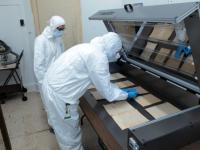In a dedicated space nicknamed “the mold room,” equipped with HVAC and HEPA filters, conservators outfitted in full Tyvek suits and latex gloves are painstakingly working to repair a priceless collection. The Price Family Papers are extensive, contained within thirteen chock-full boxes and several large files. The papers date back to 1752 and document the lives and careers of several members of Philadelphia’s prominent Price family, including Eli Kirk Price (1797–1884), a lawyer and civic leader who played key roles in consolidating the city and county of Philadelphia and establishing Fairmount Park.
When the collection first arrived at HSP as a donation from the Price family in 2017—dry, brittle, and infected by mold—the papers and photographs were unusable by anyone, including our own staff. After researching the condition of the pieces and possible remediation methods, our staff ultimately settled on a solution that combines standard practices with a new tool: a custom Ultraviolet light system developed in collaboration with New Jersey-based ClorDiSys Solutions. “Current practices for mold remediation are limited,” conservator Tara O’Brien explains, “and the few methods that truly kill mold can also be harmful to humans.”
![]()
Before (left) and after (right) conservation work on an 1842 broadside found crumpled in a box. First the document was flattened, then the edges were repaired with Japanese paper and wheat starch paste for ease of handling and to prevent further tearing.
Work has been in progress since June 2018, and early results are promising: nine spot tests had shown moderate to heavy contamination at the onset, and post-cleaning tests show mold activity is now minor to non-existent. Though the work is tedious and intensive, technician Kate Devlin finds moments of delight. “Lots of little treasures that have come up along the way, including blueprints of the Philadelphia Museum of Art’s elevation, personal letters, a lock of hair, two old skeleton keys, and wonderful portrait photographs,” Devlin reveals.
Work on this collection is expected to last several years, in part because staff time is limited to three hours per day to minimize health hazards. Once the materials are deemed safe to use, they will be processed and made available for research, and even more mold-afflicted items in our vaults can be brought back to use through this innovative process.
Support for the care and treatment of this collection is provided in large part by the Price family.
Interested in supporting our conservation work? Make a gift!

